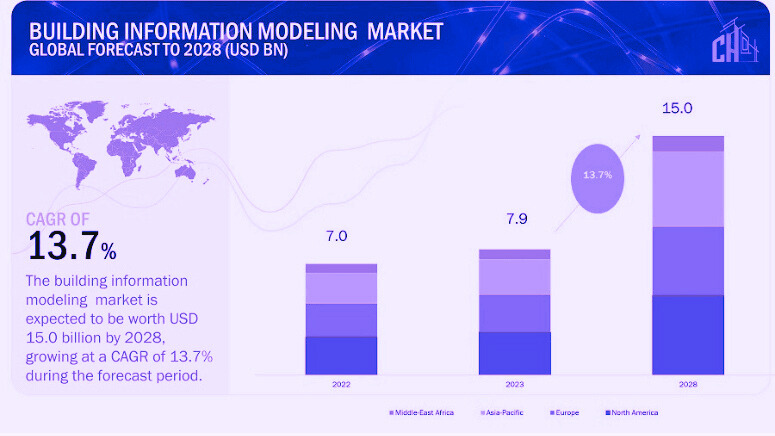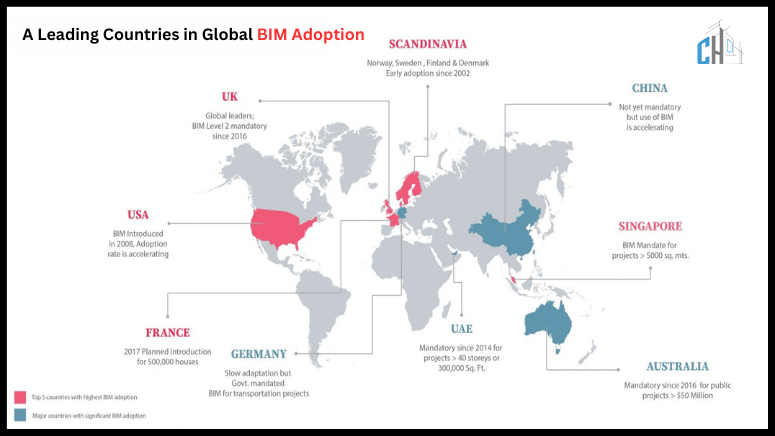Building Information Modeling (BIM) has come to represent the most transformative force in the Architecture, Engineering, and Construction (AEC) industry, bringing about radical changes in project planning, design, and implementation. With advancement into 2025, it becomes critical to recognize and investigate the BIM implementation, uncovering various strategies and tendencies in the major countries of the world.
BIM Adoption Statistics
The globally increasing adoption of BIM is coupled with a growing recognition of BIM potential to enhance collaboration, boost project efficiency, and reduce costs. Following recent statistics BIM adoption has become a byword in developed and developing countries, with the number of projects adopting BIM technologies growing each year.

The global building information modeling (BIM) market statistics report in terms of revenue was estimated to be worth $7.9 billion in 2023 and is poised to reach $15.0 billion by 2028, growing at a CAGR of 13.7% during the forecast period.
Here we go to the top 12 countries driving this world-changing technology revolution.
Top Countries at the Forefront of BIM Adoption
1. United States
In BIM implementation, the USA has been in the lead, with the cities of NY and San Francisco being on the list. The US government has also required the use of BIM for federal projects, in addition to this mandate it has become mainstream.
Building Information Modeling (BIM) was implemented early on and in the 1990s in every part of the world, its implementation was successful. The United States paved the way by figuring out what BIM development in the 1970s was going on in the construction industry.
BIM isn’t a law in all the states yet, but It is foreseen that the future is very bright. The Wisconsin State Legislature has adopted and made it obligatory for the construction of public projects to be implemented based on BIM if they cost more than $5 million. Still, it is only in the previous three years, that the implementation of BIM has intensified.
The protracted slowness of implementation of digitalization in the construction sector in the US is due to the state of experimenting. Establishing available policies and plans needed for long-term solutions are work in progress.
Some countries, such as Argentina, Brazil, and Mexico are trying to develop their awareness and train the AEC professionals with the basic idea of BIM and the advantages that it brings.
BIM(Building Information Modeling) has been widely put into practice in the USA Construction Industry where it has become a mainstream method among architects, contractors, and engineers.
2. United Kingdom
The UK has a strong BIM mandate, The establishment of a BIM mandate by the UK Government has led the country to develop an active approach towards BIM. This has improved the name of UK designers, contractors, and all types of professionals globally.
In April 2016, the government made BIM Level 2 the default choice for all public projects.
The United Kingdom’s construction industry is one of the fastest and most advanced digitalized and technological industries in the whole world.
BIM adoption national BIM report statistics from NBS have grown substantially In 2011, 43% of respondents had not heard of BIM. Today, awareness is almost universal, with 73% using BIM. BIM will become the construction industry trend in the UK, and its adoption is increasing at a high rate.
3. France
By 2006 BIM became a major movement in France but it was first utilized in 2010.
France had no BIM requirement. On the other hand, 35% of French developers are adopting BIM. In 2018, the Government of France took the initiative of BIM Plan 2022 to merge BIM into the Construction workflows.
BIM at level 2 is used in 40-50% of the French construction sector in their projects.
A Digital Transition Plan for Construction has also been urged recently in the country, seeking to embrace and drive the BIM technique in all regions to the fullest.
BIM itself has an issue of poor quality due to the scatter of BIM standards and formats.
4. Germany
Engineering is the specialty of Germany, and that is the reason why the country is so enthusiastic about BIM. German firms are the driving force of BIM innovations, they really lead the technology and standard development.
BIM was set in early in 2006 – the German construction project first in the world.
BIM is integrated into approximately 70% of German construction companies, mainly architects and specialists in design. Since January 2017 BIM has gone compulsory for projects worth over €100 million.
Due to BIM usage, there is an obligatory contract in public works related to infrastructure passed in 2020. The majority of German firms are on Level 2 of BIM but some high-scale organizational projects have already implemented Level 3.
Germany ranks among the leading nations for the development and roll-out of the National BIM strategy and for devising and consulting on BIM projects.
5. Scandinavian Region
BIM was at first used in Norway, Denmark, Finland, and Sweden as described in its very first publications. In these nations, mandates for public projects are in effect. They have been one of the global leaders in utilizing BIM for implementation and adoption.
6. Russia
BIM came into the Russian market in 2014 officially while its presence as an official entity in the Russian construction market was in 2019. A set of rules relevant to BIM developed in 2018 and later in 2020, turned out to be a standard for BIM establishment and maintenance.
BIM legislation standardizing and enacting 15 national standards and 8 sets of information modeling laws lead Russia as a country on top on the scale. The Government mandated the use of BIM technology since 2022.
2022 BIM Technology Market Growth by 14.4%. 2025 National Standard Report Statistics on Information Modeling Technologies for Residential Buildings Approved. At the moment, BIM is utilized in Moscow, St.Petersburg, Kazan, Ufa, and Yekaterinburg by realty developers and construction companies. To Russia, the installation of good and consistent government rules with the right support for BIM implementation acts as a motivation force for rapid BIM adoption in Russian construction.
7. Finland
Finland was the first country to adopt BIM at the end of the year 2002. In 2007 Senate Properties, with a majority government stake that is responsible for managing the country’s property assets, enforced IoT compliance and BIM seedling in all their projects.
BIM implementation is highest in this country due to the fact that in 2007, 93% of architectural firms and 60% of engineering firms were doing BIM in their daily operations.
8. Australia
Australia has been a fast follower in terms of BIM implementation, with Sydney and Melbourne being the two main cities in the lead. The Australian government has also legislated BIM for all big infrastructure projects, thus spurring its use.
The ‘Australia Construction Market Size, Trend Analysis by Sector, Competitive Landscape and Forecast, 2023-2027″ Report has been added to ResearchAndMarkets.com’s offering.
The Australian construction sector is expected to grow by 4.1% in real terms this year and this is mainly due to an increase in total construction work within the country, which is largely attributed to the strong performance of engineering work.
The Australian Bureau of Statistics (ABS) reported an increase of 8.4% during the first six months of 2023 in the total value of construction work done in Australia compared to the same period the previous year.
This increase was due to a 16.0% rise in civil engineering and a 2.4% rise in building work done in the period. Yet, the projected output of the construction sector in 2025 is expected to decline by about 2.5% due to low investor and consumer confidence caused by high inflation, interest rates, construction costs, lowered building permits, shortages of labor, and the residential construction sector’s downward spiral.
9. Canada
Among the North American countries, Canada is still at the forefront of BIM adoption. Government actions and business-wide cooperation have served as the key factors in normalizing BIM standards and practices. In these countries, the information on BIM in the AEC industry is increasingly seen as the reason for cost savings, clash detection, and project timelines during delivery.
BIM is mandatory for all federal projects under the Canadian government. This has resulted in widespread adoption throughout the country, making Canada lead the world in BIM technology.
10. China
The adoption of the BIM in China has risen substantially since 2016. The BIM adoption policies released by Chinese AEC professionals together with multiple organizations on their part have fully embraced growth and digitization.
BIM is an important part now and has become a central element and it is being used for almost all their projects. Even the government of China is also termed to have a keen interest in the BIM adoption policies. It has not been made compulsory to use BIM, though its application is highly appreciated.
China is a widely spread country with a growing economy, but the construction industry of this land is highly fragmented on a regional basis. In general, the adoption of BIM is being paid great attention to.
11. United Arab Emirates
The UAE’s economy is a growing and urbanized one with the construction sector being its supportive sector so as to this overwhelming growth. Most prominent buildings were using BIM and with the rise of the mandate passed by the government in 2014, they have been the top before the government mandate.
They are all supposed to be for projects which are above 40 stories and more than 300,000 sq.ft. In spite of the fact that BIM has a slow adoption in the UAE, still some of the major schemes have used BIM.
12. Singapore
Singapore has always been known for being progressive when it comes to technology and BIM is not a different story. The Singaporean government passed the decree to use BIM for all large-scale construction projects, which contributed to its rapid adoption.
Since 2015 all the public projects in Singapore have adopted BIM, which is the responsibility of the construction authority of Singapore. The Singapore Government has earmarked the sum of $250 million as the total fund for BIM implementation.
Singapore emphasizes BIM to digitize the sector. The Construction and Records Opening Network, CORNET, embraced BIM e-submission in 2015.
The BIM (Building Information Modeling) has been made compulsory by them in all the projects which are greater than 5000 sq. mts. BIM implementation has been a success in Singapore’s construction sector. This can be proven by the industry’s productivity.
Conclusion
As summing up, we spotlighted the top 10 countries that are ahead of the global tech revolution in construction via BIM adoption. These nations have a lot of data pertaining to BIM implementation.
The countries in Europe that are worth mentioning are Norway, Denmark, Finland, Sweden, Austria, and Denmark which are at BIM level 2 in construction. Furthermore, the UAE, Japan, and India have become respectively matured in respect to BIM integration.
CAD technology helps construction industries all over the world increase their building design and production efficiency. The timely use of BIM has a noticeable effect on participants. BIM modeling outsourcing services to be competitive again.
Chudasama Outsourcing is a highly reputable BIM outsourcing company that provides the best BIM and CAD solutions to maximize the efficiency of construction processes. Our solutions are scalable, cost-efficient, and compatible with world construction standards.




